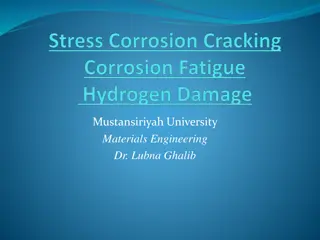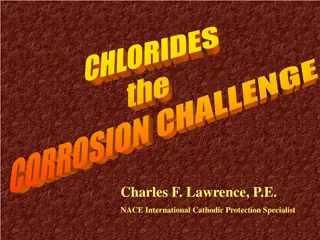Factors Influencing Corrosion Rate in Materials Engineering
Factors influencing the corrosion rate in materials engineering include the nature of the metal, purity, physical state, oxide film, areas of anode and cathode, solubility of corrosion products, volatility of corrosion products, and the corroding environment's nature like temperature, humidity, and pH level. These factors affect the rate and extent of corrosion in metals and alloys, impacting their durability and reliability in various environments.
Uploaded on Sep 12, 2024 | 1 Views
Download Presentation

Please find below an Image/Link to download the presentation.
The content on the website is provided AS IS for your information and personal use only. It may not be sold, licensed, or shared on other websites without obtaining consent from the author.If you encounter any issues during the download, it is possible that the publisher has removed the file from their server.
You are allowed to download the files provided on this website for personal or commercial use, subject to the condition that they are used lawfully. All files are the property of their respective owners.
The content on the website is provided AS IS for your information and personal use only. It may not be sold, licensed, or shared on other websites without obtaining consent from the author.
E N D
Presentation Transcript
Materials Engineering Dr. Lubna Ghalib
Factors Influencing Corrosion Rate: The rate and extent of corrosion, depends on the following factors: 1. Nature of the metal: Position in the galvanic series: The greater the oxidation potential, when the metal is higher up in the galvanic series, greater is its tendency to become anodic and hence greater is the rate of corrosion. Purity of metal: Lesser is the percentage purity of a metal, faster is the rate of corrosion. The impurities present in metal cause heterogeneity and thus tiny electrochemical cells are set up at the exposed part of the impurity and corrosion of metal around the impurity takes place due to local action. Physical state of the metal: The rate of corrosion is influenced by physical state of metal. The smaller the grain size of the metal or alloy, the greater will be its corrosion. Moreover, areas under stress, even in a pure metal, tend to be anodic and corrosion takes place at these areas. .
Nature of the metal: Nature of the oxide film: The ratio of the volumes of the metal oxide to the metal is known as "specific volume ratio". Greater the specific volume ratio, lesser is the oxidation corrosion rate. Relative areas of the anode and cathode: When two dissimilar metals or alloys are in contact, the corrosion of the anodic part is directly proportional to the ratio of the cathodic part and the anodic part. When cathodic area is smaller, the demand for electrons will be less and this result in the decreased rate of dissolution of metal at anodic regions. Solubility of corrosion products: In the electrochemical corrosion, if the corrosion product is soluble in corroding medium, then corrosion proceeds at a faster rate. For example, Pb in H2SO4 medium forms PbSO4 which is insoluble in the corroding medium, hence corrosion proceeds at a smaller rate. .
Nature of the metal: Volatility of corrosion products: Rapid and continuous corrosion of metal take place if corrosion product is volatile. This is due to the fact that as soon as corrosion product is formed, it volatilize, thereby leaving the underlying metal surface for further attack. .
Nature of the corroding environment: 2. Nature of the corroding environment: Temperature: With increase environment, the reaction as well as diffusion rate increase, thereby corrosion rate is generally enhanced. Humidity of air: The greater is humidity, the greater is the rate and extent of corrosion. This is due to the fact that moisture acts as a solvent for O2, H2S, SO2 and NaCI etc. to furnish the electrolyte essential for setting up a corrosion cell. Effect of pH: Corrosions of that metal which are readily attacked by acids can be reduced by increasing the pH of the attacking environment. . of temperature of
Nature of the corroding environment: Presence of impurities in atmosphere: Corrosion of metals is more in areas near to the industry and sea. This is due to the fact that corrosive gases like H2S, SO2, CO2 and fumes of H2SO4 and HCI in the industrial areas and NaCI of sea water leads to increased conductivity of the liquid layer in contact with the metal surface, thereby increase the corrosion rate. Presence of suspended particles in atmosphere: In case of atmospheric corrosion; (a) if the suspended particles are chemically active in nature [like NaCl, (NH4)2SO4], they absorb moisture and act as strong electrolytes, thereby causing enhanced corrosion; (b) if the suspended particles are chemically inactive in nature (e.g., charcoal), they absorb both sulphur gases, and moisture and slowly enhance corrosion rate. .























